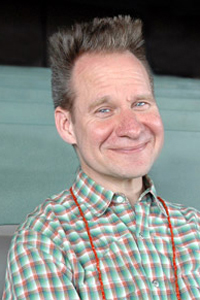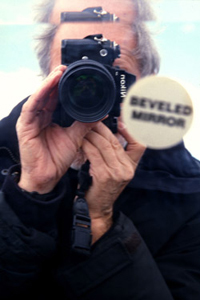Revolutionary artists in theater, film, music, conceptual art to demonstrate how ‘ARTSPEAKS’
By Josh SchonwaldNews Office
|
|
|
Three artists—director Peter Sellars, violinist/composer Daniel Bernard Roumain and conceptual artist Hans Haacke, who have contributed revolutionary new approaches to their art—will be coming to the University campus this winter as part of the Artspeaks Fellows program.
The Artspeaks program will kick off Thursday, Jan. 10, with the arrival of Sellars, who is widely regarded as one of the world’s most innovative leading directors for his modern productions of classical opera and plays. The cornerstone of Sellars’ Chicago visit will be his lecture, titled “Art and History,” at 7:30 p.m. in Mandel Hall.
A professor of world arts and culture at the University of California, Los Angeles, who has directed more than 100 productions in opera, theatre and film, Sellars has been creating inventive, dramatic interpretations since his undergraduate years at Harvard University. It was there that he performed a puppet version of Wagner’s Ring Cycle and produced Antony and Cleopatra in the swimming pool of Harvard’s Adams House. During his senior year, Sellars’ production of Handel’s Orlando at the American Repertory Theatre in Cambridge brought him national attention for his original, modern staging.
In 1983, only two years after graduating from Harvard, Sellars received a MacArthur Foundation “Genius” grant. After studying in Japan, China and India, he became artistic director of the Boston Shakespeare Company. At the age of 26, he became the director of the American National Theater at Kennedy Center.
Sellars is equally renowned for his work in opera, having directed original and contemporary visions of classic operas, including Mozart’s Cosi Fan Tutte, which he staged in a diner on Cape Cod, and Don Giovanni, which was performed in New York City’s Spanish Harlem. He also re-imagined numerous 20th-century operas, from Olivier Messiaen’s St. François d’Assise and Paul Hindemith’s Mathis der Maler to John Adams’ and Alice Goodman’s Nixon in China.
Though Sellars is best known for his work in opera and theatre, he has worked extensively in film and video, including directing a music video for Herbie Hancock and the 1991 feature film, The Cabinet of Dr. Ramirez. The film, both silent and in color, starred Joan Cusack, Peter Gallagher and Mikhail Baryshnikov.
Sellars will be in Chicago staging John Adams’ Doctor Atomic at the Lyric Opera. David Levin, Associate Professor of Theater and Performance Studies, Cinema and Media Studies and Germanic Studies, notes the work is intimately tied to the University, as it focuses on the moral and political quandaries of the group developing the first atomic bomb.
“Peter Sellars’ ties to the University transcend the thematics of this opera. More than any artist I know, he is a born pedagogue,” said Levin. “His learning is vast, his vision extensive and his enthusiasm infectious.”
A classical violinist paired with a disc jockey; a hip-hop infused opera. Chamber works, rock songs, electronica and funk. A multimedia collage of YouTube and MySpace clips paired with a six-string violin, piano and electronics.
The New York Times described Daniel Bernard Roumain to be “about as omnivorous as a contemporary artist gets.” Best known for fusing classical music with myriad styles and sounds, DBR, as he is known, is a composer, performer and band leader who is constantly re-interpreting music.
DBR will visit campus for a concert at 7:30 p.m. Friday, Feb. 1, in Mandel Hall. Travis Jackson, Associate Professor of American Music in Music and the College, will moderate a discussion session following the concert.
“He’s fascinating,” said Shauna Quill, Executive Director of the University of Chicago Presents. “He performs, he composes. He’s a multimedia artist. He brings contemporary life into his program,” she said. “And everything he does is so thoughtful.”
“For lack of a better word,” said Quill, “he’s at the pinnacle of cool in the music world.”
As a composer, DBR’s pieces range from orchestral scores and chamber works to rock songs and electronica. As a violinist, he has worked with artists spanning the gamut—from DJ Spooky and Vernon Reid to Savion Glover, Susan Sarandon and Cassandra Wilson.
DBR has collaborated with numerous orchestras and chamber ensembles, as well. He worked with the Tuscaloosa Meditations to create an original piece commemorating the heroism of the desegregation of the University of Alabama; the Vermont Youth Orchestra, which performed Voodoo Violin Concerto, a virtuosic musical piece that explores DBR’s Haitian heritage; and the American Composers Orchestra, which performed his orchestral work, Call Them All: Fantasy Projections for Film, Laptop and Orchestra, at its world premiere in Carnegie’s Zankel Hall.
A classically trained composer who earned a Ph.D. in music composition from the University of Michigan, DBR is currently the leader of the band, DBR and the Mission. “You never know what he’s going to do next,” said Quill. “He’s constantly seeking new projects and coming up with surprising ideas.”
Haacke, an acclaimed and controversial conceptual artist, will come to campus in April 2008. Haacke will give a presentation titled “Dog and Pony Show,” which will be followed by a moderated conversation.
“Haacke has spent decades digging around with the often-messy intersection of art, commerce and politics and has used a wonderful variety of means to transform that research into powerful works of art,” said Stephanie Smith, Director of Collections and Exhibitions at the Smart Museum of Art. “His work has helped spark crucial conversations about the roles of art and art institutions in contemporary society. He’s also known as an intense, irreverent and engaging speaker, so his ‘Dog and Pony Show’ is sure to be quite an event.”
A German native and a professor at The Cooper Union for more than two decades, Haacke has produced work in a staggering range of art forms that includes sculpture, installation, painting, photography, posters, prints, books and a stage set. One of his best-known recent works is a piece from 2000 that the German Parliament commissioned and which is permanently installed in the open-air courtyard of the Reichstag.
Much of Haacke’s work has examined systems and processes. Much of his earlier work focused on physical and biological systems, such as the states of water made visible in his sculpture “Condensation Cube.”
His later works explored socio-political structures and the politics of art. “Shapolsky et al. Manhattan Real Estate Holdings, A Real Time Social System, as of May 1, 1971” exposed the questionable transactions of Harry Shapolsky’s real-estate business dealings between 1951 and 1971.
Haacke gained international renown for his one-artist show scheduled to be exhibited in 1971 at the Guggenheim Museum. The museum’s director canceled the show six weeks before its planned opening because he felt that the Shapolsky piece pursued “aims that lie beyond art.” Another exhibition met with a cancellation at the Wallraf-Richartz Museum, where Haacke included the work “Manet ’74,” which connected the funding of the museum to the cultural politics of the Cold War.
Haacke’s paintings have been exhibited at the University in the past. A 1979 solo exhibition at The Renaissance Society featured highly political paintings that reproduced and altered print ads for Mobil, Allied Chemical and Tiffany & Co.
Now in its fourth year, the University’s Artspeaks Fellows Program brings three distinguished artists to campus each academic year for residencies of various lengths, offering the University community and the community-at-large a rare chance to experience preeminent artists in an intimate setting. The University’s Arts Council and the Office of the President provide funding for the program.
Each residency includes a public presentation and participation in seminars and classes. Previous presidential fellows are Anne Bogart, Uri Caine, Atom Egoyan, Neil Gaiman, Bill Jones, James Schamus, Anna Deavere Smith and John Zorn.
For more information on the Artspeaks Fellows Program, please visit http://arts.uchicago.edu/artspeaks.html.
![[Chronicle]](/images/sidebar_header_oct06.gif)


